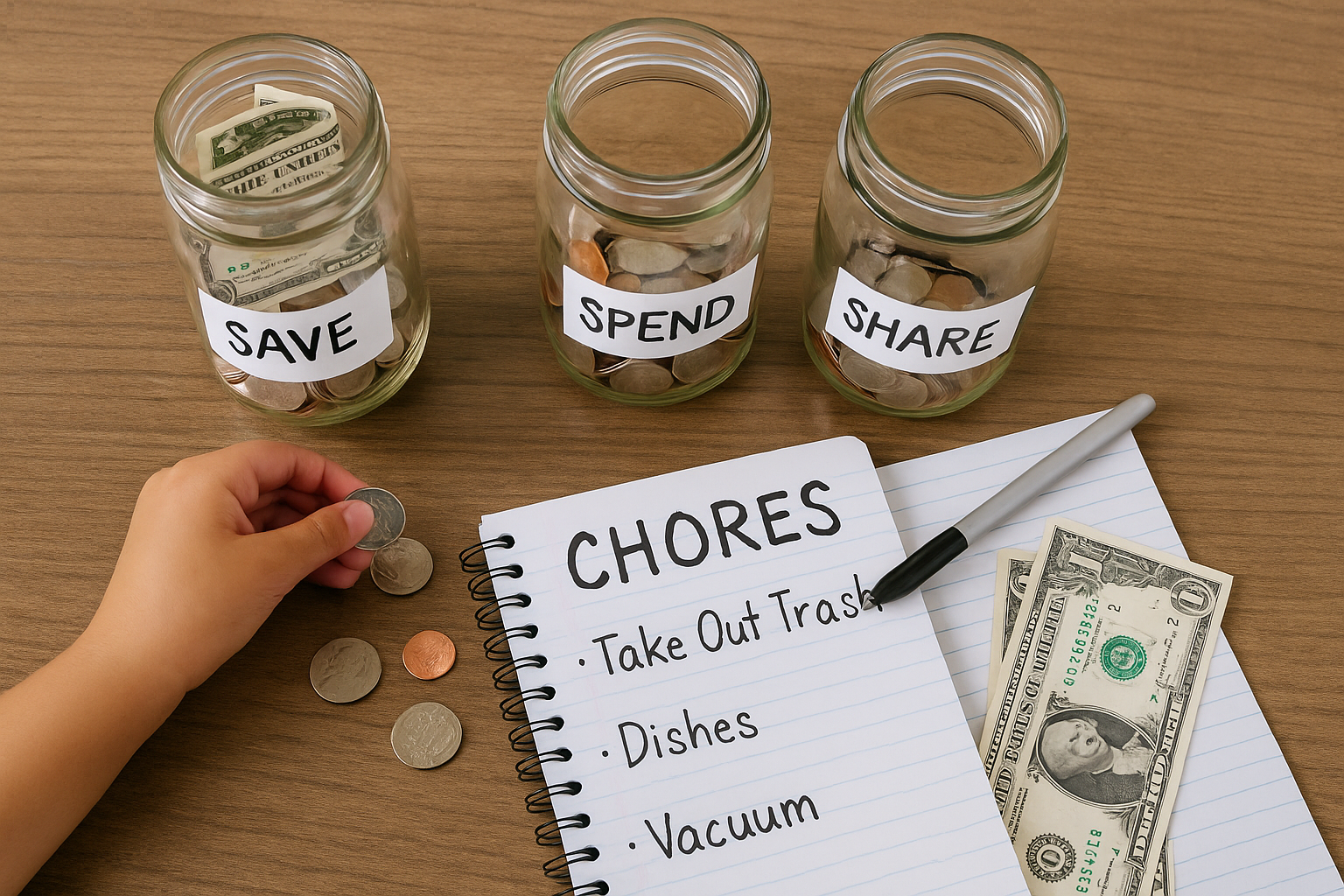Money confidence is a skill, not a personality trait—and a good kids allowance system is one of the easiest ways to teach it. The goal isn’t perfection; it’s repetition: regular practice earning, choosing, saving, and giving. Use the playbook below to set up a calm, sustainable system in under an hour.
Why an Allowance Helps
- Low-stakes practice: Kids learn to trade off “now vs. later” while the amounts are small.
- Built-in “money lessons”: Saving for goals, spending within limits, and choosing causes to support.
- Fewer store meltdowns: A budget they control turns “Can I have it?” into “Do I want to spend my money on this?”
The 3-Bucket System (simple and visual)
Give each child three clearly labeled jars (or digital “buckets”): Save, Spend, and Share.
- Save (longer-term goals): A toy over $20, a bike, or camp. Add pictures of the goal for motivation.
- Spend (week-to-week wants): Small treats, in-game purchases, crafts.
- Share (generosity): Charity, school drives, gifts for others.
Starter split: 50% Save, 40% Spend, 10% Share for younger kids; shift to 40/40/20 as goals get bigger.
How Much & How Often?
- Amount: Many families use $0.50–$1 per week per year of age (e.g., a 10-year-old gets $5–$10). Choose a number that fits your budget and reduces constant negotiating.
- Frequency: Weekly works best for younger kids. Teens can handle biweekly “paydays.”
- Format: Physical cash is powerful for younger kids; older kids may prefer a supervised debit card or youth banking app.
Chores vs. Allowance (the calm approach)
Big debate: should allowance be tied to chores? Try a hybrid that keeps life skills and money skills clear:
- Base allowance is not payment for existing family responsibilities. Everyone participates in age-appropriate chores (making the bed, clearing the table) because they’re part of the household—not to “earn” basic living.
- Offer optional paid “above-and-beyond” tasks. Yard work, washing the car, organizing the garage. Post a rotating list with prices so kids can earn extra by choice. This keeps motivation positive and avoids daily bargaining.
This setup cleanly separates chores vs allowance while still teaching the link between effort and earnings.
Set It Up in 5 Steps
- Pick your amount and day. Example: “Every Saturday you’ll get $6—$3 Save, $2 Spend, $1 Share.”
- Create the three buckets. Clear jars + printed labels or a youth account with sub-accounts.
- Define family jobs vs. paid extras. Put a simple list on the fridge with prices for optional tasks.
- Do a mini money date. Five minutes each week: distribute allowance, move money into buckets, and talk about goals.
- Let natural consequences teach. If “Spend” is empty, wait for next allowance or earn via an extra task. No bailing out with parental money.
Age-by-Age Tips
- Ages 5–8: Use cash and clear jars; keep goals small (stickers, small toy). Practice counting and simple change.
- Ages 9–12: Add price comparison, “unit price” games at the store, and bigger Save goals (headphones, sports gear).
- Teens: Shift to digital buckets and a monthly teen budget (lunches, outings, small clothing items). Introduce banking basics, interest, and “pay yourself first.”
Coaching Scripts (short and pressure-free)
- At the store: “You can buy it from your Spend bucket. Want to get it now, or save for the bigger thing?”
- When a bucket is empty: “Looks like Spend is at zero. Would you like to choose an extra task to earn more, or wait until Saturday?”
- On giving: “This month we have $3 in Share. Which cause or person do you want to support?”
- On saving goals: “Your Save bucket has $18. The goal is $30. What’s your plan—wait two weeks or do a $6 extra task?”
Common Pitfalls (and easy fixes)
- Inconsistent “paydays”: Put a recurring reminder on your calendar; make it a quick weekly ritual.
- Covering shortfalls: Avoid loaning from parents. Offer extra-earn opportunities instead.
- Too many rules: Keep it simple. Three buckets + one list of extra tasks beats a complex spreadsheet.
When to Update the System
Revisit the amount annually (birthday or school year). As kids show responsibility, expand freedom: bigger Save goals, prepaid card access, or planning part of a family purchase (like a game pass or a day trip).

Leave a Reply